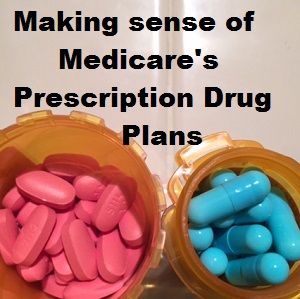
Center for Medicare and Medicaid Services training module for Prescription Drug Plans, 2015.
2015 CMS PDP Training
Prescription drug coverage for Medicare beneficiaries can be confusing. Under different health care scenarios some drugs may be covered by Part A, Part B or Part D of Medicare. In addition, many Medicare beneficiaries may be unaware that they might qualify for extra help to pay for their medications. The Centers for Medicare and Medicaid Services have put together a training presentation, workbook and job aids to address some of the moving parts of drug coverage under Medicare.
Medicare Prescription Drug Plan Training Module
The following information pertains to individuals who have Original Medicare fee-for-service coverage. In other words, individuals who have Medicare Parts A and B and have enrolled in a Part D Prescription drug plan. Some individuals may have a Medicare Supplement or Medigap plan, but drug coverage is not benefit of supplement plans. People who are enrolled in a Medicare Advantage health plan that include prescription drug coverage will receive all their medication coverage through that Medicare Advantage health plan. Below is a high level overview of the training. For more in depth information download the training presentation or workbook at the end of the post.
Part A Hospitals and Hospice
- Part A inpatient hospital or skilled nursing facilities coverage generally pays for drug under this health care setting. This extends to hospice care for symptom and pain relief only.
- Part A won’t cover normal prescription medication you may take when admitted to a hospital.
- If you have to receive normal prescription medication during a hospital stay, and the hospital pharmacy is out-of-network for your Part D Prescription Drug plan, you may be billed for the medication and then need to submit a claim for reimbursement from your PDP.
Part B Outpatient health care services
- Part B covers limited outpatient drugs such as injectable and infusion therapy when delivered at the doctor’s office or outpatient facility.
- Certain drugs administered during treatment for End-Stage Renal Disease.
- Drugs utilized and administered as part of durable medical equipment such as a nebulizer.
- Oral drugs with special coverage include anti-cancer, nausea (antiemetic), and immunosuppressive.
- Coverage for certain immunizations such as flu, pneumonia, hepatitis B
Part D Plan Covered Medications
- Prescription brand-name and generic drugs
- Not all manufactures of a drug may be included in a sponsors Part D Prescription drug plan.
- A range of drugs from six different categories must be offered in the PDPS: cancer, HIV/AIDS, antidepressants, antipsychotics, anticonvulsive, and immunosuppressant.
- Certain vaccines such as for shingles is covered, that may not be covered under Part B
- Each PDP will have a list of covered drugs known as a drug formulary
- There are usually four tiers of drugs in the formulary but some can have as many as six:
Tier 1 Generics
Tier 2 Preferred Brand Name
Tier 3 Non-Preferred Brand Name
Tier 5 Unique, specialty, injectable
Tier 6 Specific drugs that may be $0 cost such as blood pressure or cholesterol medications
- Some drugs require prior authorization, step therapy and quantity limits.
- PDP members can file an appeal to have their PDP carrier place a drug on the formulary that their doctor would like to prescribe.
- Under certain health and cost conditions pharmacists can perform a Medication Therapy Management review to make sure there are no drug interactions and how to get the most benefits out of the PDP coverage.
- You can change your PDP drug plan every year during the annual open enrollment period.
Extra help paying for Medicare prescriptions
Getting “Extra Help” means Medicare helps pay your Medicare prescription drug coverage monthly premium, any yearly deductible, coinsurance, and copayments. If you have limited income and resources, you may get Extra Help paying for your Medicare prescription drug costs. Extra Help is also called the low-income subsidy (LIS). Eligibility is based on-
- Income below 150% of the federal poverty line ($1,471.25 per month per individual, $1,991.25 per monthly family size of 2, 2015 levels)
- Resource limits of $13,640 for a single, $27,250 for a couple, excludes primary home, higher amounts in Alaska and Hawaii.
- Automatically eligible if receiving Medicaid, Supplement Security Income or help paying for Part B premium.
- Applications for Extra Help are run through the Social Security Administration
- Eligibility is re-determined annually
Requesting a medication not covered (This applies to MA-PD plans as well)
- PDP members can request that the plan them to receive a drug that is not on the plan’s drug formulary.
- The PDP plans must respond within 72 hours and within 24 hours for expedited requests.
- Requests can also include reducing a current covered drug to a lower tier to save money or to waive the step therapy rules where a generic alternative must be taken before receiving a Brand name drug in the formulary.
- A denial by the plan can be appealed by you, your doctor, or an appointed representative.
- Module 9 explains Medicare Prescription Drug Coverage under all parts of Medicare.
This training module was developed and approved by the Centers for Medicare & Medicaid Services (CMS), the federal agency that administers Medicare, Medicaid, the Children’s Health Insurance Program (CHIP), and the Federally-facilitated Health Insurance Marketplace. The information in this module was correct as of May 2015. To check for an updated version of this training module, visit CMS.gov/Outreach-and-Education/Training/CMSNationalTrainingProgram/Training-Library.html.
PDP resource training files
- [wpfilebase tag=fileurl id=654 linktext=’2015 Medicare Drug Coverage Training Presentation’ /]
- [wpfilebase tag=fileurl id=655 linktext=’2015 LIS Income Levels’ /]
- [wpfilebase tag=fileurl id=653 linktext=’2014-2015-Standard Drug Benefit Design’ /]
- [wpfilebase tag=fileurl id=656 linktext=’2015 Medicare PDP Coverage Workbook’ /]
Standard PDP Drug Benefits for 2015
[gview file=”https://insuremekevin.com/wp-content/uploads/2015/06/2014-2015-Standard-Drug-Benefit-Job-Aid.pdf” save=”1″]


